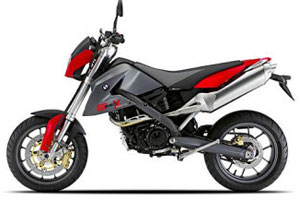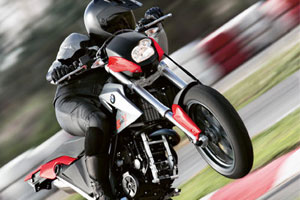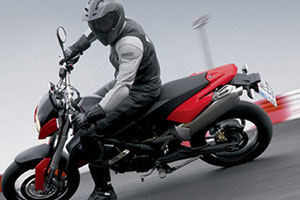BMW goes from mild to wild with the 2008 model G 650 Xmoto supermoto screamer.

BEEMER TRIFECTA
It is incredible that three bikes with the same engine and frame, with similar components, can make such different handling and looking motorcycles.
The BMW G 650 Xchallenge was the first of the G series to land in the country last year, with the Xmoto and Xcountry now joining it to complete the line up. All three are good motorcycles in their own ways, although it is expected that the Xchallenge will be the number one seller.
The off-road adventure style bikes are proving to be popular among new buyers these days, although it is pretty amazing that slight suspension changes and different wheels can create such a great handling supermoto ride for the street.
Smack in the middle is the Xcountry, a bike designed for both worlds, and not quite as narrow focused as the others.
BMW has done a great job in piecing together the puzzle, and personally, I wouldn’t mind having all three in my garage.
SPECIFICATIONS
ENGINE
Engine type: Water-cooled, single-cylinder, four-stroke, four valves, two overhead camshafts, dry sump lubrication
Bore x stroke: 100 mm x 83 mm
Displacement: 652 cc
Compression ratio: 11.5:1
Transmission: Five speed
Power (claimed): 52hp
Torque (claimed): 44ft-lbs
CHASSIS
Frame type: Bridge-type steel section frame with bolted-on cast aluminium side elements, bolted-on aluminium rear section
Front suspension: Upside-down 45mm front fork, rebound and compression damping adjustable
Rear suspension: Cast aluminium dual swing arm, height-adjustable central spring strut, spring pre-load and rebound damping manually adjustable
Wheelbase: 1500mm
Wheels (front/rear): Cast aluminium 3.50 x 17″ / 4.50 x 17”
Tyres (front/rear): 120/70 H 17 / 160/60 H 17
Brakes (front/rear): Single disc, diameter 320 mm, four-piston fixed calliper / Single disc, diameter 240 mm, single-piston floating calliper (ABS an optional extra)
DIMENSIONS
Weight (claimed): 147kg
Seat height: 880mm
Fuel capacity: Not given
PURCHASE DETAILS
Price: $15,250 + orc
Colour options: Graphitane Matt Metallic / Red
Test bike from: BMW Motorrad Australia (www.bmwmotorrad.com.au)
Okay, I confess. When AMCN deputy editor Matt Shields told me that I would be testing the BMW G 650 Xmoto for the magazine, I honestly didn’t have a clue what he was talking about. It’s not that I have anything against the brand, but I had just never really paid a huge amount of attention to it. When I thought of the German manufacturer, I thought of touring-style bikes that suit old men.
A quick look on BMW’s website to do some research on my new steed and I was quietly surprised by what I found — a water-cooled, four-valve, 652cc single-cylinder supermoto weapon that looked like a bundle of fun to take for a blast.
It seems BMW has committed to attracting a younger audience for its motorcycle range and, frankly, supermoto bikes are the ultimate hoon machines which get the hearts of almost any young rider pumping.
Once I picked up the bike and took it for its initial spin, I knew BMW was on to something straight away. The engine is broad and powerful for a single, with an impressive chassis to match. Whether you like tight city streets or wide open country bends, the BMW has the ingredients to thrill.
Suddenly, after one test on a BMW motorcycle, my entire outlook has changed. The Xmoto has single handedly taken the company from obscurity to being a serious contender in my world and I’m glad I’ve discovered it. I’m sure many other younger riders are now beginning to take BMW as a serious option, too, as they create more exciting and sportier bikes.
Of course I have heard plenty about the brand before, with both Shieldsy and AMCN editor Mick Matheson raving about various bikes in the company’s line up, but this was my first time to ever sample one for myself.
And with BMW’s long awaited world Superbike debut set to happen in a year or two, it looks like the brand will hit an even wider audience of new generation riders.
At first glance, the Xmoto is a nice bike, but not a massive standout. An hour or two later, my opinion began to change. The bike’s styling seems to grow on you the more you check it out, and soon enough I actually really began to like it.
That positive opinion is increased even more after riding the bike, and you soon realise that its styling is a spot on match for its wild character with random traits that make it an extremely personal ride.
A funny thing about the Xmoto is that people either love it or hate it. Some people who saw it would be like “wow, that thing’s trick”, while others would smirk at it and try to compare it to Ducati’s Hypermotard or similar.
But that’s not what this bike is about and a bike like the twin-cylinder Hypermotard is a completely different kettle of fish. The Xmoto is the ultimate supermoto versatility machine, comparing much different to the bigger motard machines while still being more road friendly than the likes of a Husqvarna’s SM-R range or Aprilia’s SXV range.
It isn’t overly big and bulky, but still very stable and has a decent amount of grunt, while its behaviour on freeways or on open stretches of road with sweeping corners is quite a bit better than your average supermoto single. The Xmoto fits right in between.
One bike that could be compared pretty evenly is KTM’s 690 SM range. Although I haven’t had the chance to ride our long term Prestige model yet, both are extremely versatile motard fun runners with the ability to ride further.
Comparing the Xmoto with its two sister models, the Xchallenge and Xcountry, is pretty simple really. They all share the same tubular steel bridge frame with aluminium subframe and swingarm, and the same engine, although ride and look distinctively different.
The G series range is a clever little bunch that makes good use of what is a solid engine and also has an excellent chassis with a quality selection of components.
A softcore model in the G series, the Xcountry is built to be an all rounder, with features from the more off-road-happy Xchallenge and also from the more tarmac laden Xmoto.
The Xchallenge was the first in the G series to be released last year, with the Xmoto and Xcountry joining it to complete the range.
All three share the same 45mm upside-down Marzocchi forks, although the Xchallenge and Xmoto both feature adjustable rebound and compression damping and have 270mm worth of travel. The Xcountry only has 240mms of travel and is non adjustable.
At the rear of the bike, the Xmoto and Xcountry both have fully adjustable Sachs shock absorbers, with the Xmoto featuring 215mm of travel and the Xcountry 210mm. Compare this to the Xchallenge that’s designed with off-road riding in mind, and it has an air dampened system with a massive 270mm of travel.
The Xmoto features 17-inch cast aluminium wheels front and rear, strapped with grippy Pirelli Diablo tyres intended for extreme supermoto street riding, while the other pair have spoked wheels and completely different rubber fitted — 19-inch front and 17-inch rear on the Xcountry, and 21-inch front and 18-inch rear on the Xchallenge.
Surprisingly, the Xmoto is a kilogram lighter than the Xcountry at a claimed 159kg fully fuelled, although the Xchallenge is three kilos lighter again at 156kg — probably mostly thanks to its wire wheels.
Styling of the Xmoto is supermoto bad boy at its finest, although in a different kind of way. The Beemer’s supermoto purpose is obvious in the way it features the 17-inch wheels and has plenty of suspension travel to play with, dirt bike handlebars, radiator shrouds, rear guard, side plates, long seat, and an exhaust pipe similar to your average supermoto screamer.
On the other end of the spectrum is that it’s also obvious that this bike would make a good road bike — almost up to the spec of a decent nakedbike without the whopping horsepower of some on the market.
The Xmoto is quite large, pretty wide, and gives the outright feel of a road bike when in that sort of environment, but transforms back to suit the supermoto silliness that it’s designed for when in urban areas.
Speaking about the fine line between being a supermoto bike or a road bike, I would prefer to see a front guard mounted just below the excellent looking headlight ala the KTM 690 SM or Ducati Hypermotard to give it that final supermoto touch.
The digital instrumentation on the bike is clean and easy to read, with only the necessary features such as speedo, odometer, trip metres, time and warning lights included. It is a nice finish and suits the bike’s design.
Not too appealing for me is the oversized exhaust pipe. It’s like a growth off of the side of an otherwise great looking bike, and if I had this bike in my garage I would be purchasing the aftermarket Akrapovic slip-on sport silencer that is available in the accessories catalogue. That should do the trick.
Not sure what it does for the bike’s quiet sound, but a bit of toughening up wouldn’t do it any harm in any case. An exhaust manifold is also available to fatten up the power, although that is not crucial.
Another feature which sets the G series bikes apart from the norm is the fuel tank being placed underneath the seat. Filling a motorcycle up from the side attracts attention at the servo, even to the point that the attendant didn’t realise I was in position to fill the bike up — refusing to activate the pump before I proved the fuel cap wasn’t in the usual place behind the ’bars.
Speaking of fuel, the 9.5 litre tank (compared with 13.5 litres on the KTM 690 SM) could become painful, forcing riders to fill up around every 120km. I used 5.7L/100km having a fair dip, so fuel mileage is actually pretty good. Shame about the tank capacity though.
The Xmoto has brilliant four-piston calliper Brembo front brakes on a 320mm single disc to pull the bike up in a flash in almost any situation. The front brakes on the Xmoto are the highest quality in the G series, while they all share the same 240mm single disc and calliper rear brake.
It’s strange that a company with BMW’s quality failed to use an adjustable front brake lever — especially considering the Xmoto has upgraded callipers over the other two.
The optional ABS brakes on a supermoto bike is kind of a conflict of interest, although the option to switch it off is a good one when in hoon mode. Just don’t forget to turn it off when you try to back it in like a pro supermoto racer. I prefer it off.
Riding character is great. The tight streets and city ‘playground’ was enjoyable on the Beemer, flicking it around and taking advantage of the bike’s ability to turn tight and its light weight.
It sits rear high/nose low and has the tightest of turning circles, giving ultra-sharp handling. I did think it was a little high in the rear, which made it a little more difficult to manoeuvre, although who am I to complain at 168cm tall. Its seat height of 880mm is five mm higher than the KTM though. That seat is a mighty hard one at that, causing discomfort after a fair stint in the saddle.
Pointing back to its road bike tendencies, the most fun I had on the Xmoto was out through an open stretch of cambered corners, where I flowed from each twist to each bend and it was awesomely fun.
The engine was every bit the chassis’ equal match, with both combining to create a fun filled bike that was capable of going fast without overstepping the limits.
Speed isn’t a huge problem with the 52hp engine, the chassis’ weight allowing it to pull pretty well at either high or low speed. The gearing’s taller on the Xmoto than its siblings, giving it a slightly broader range of power for road use while still well off the bottom with no problem.
I did experience a few selection troubles with the five-speed gearbox though, as the high revving engine makes it critical to get your shifting right.
Now that my test ride is over, I kind of miss my first Beemer. The G 650 Xmoto was a great introduction for me to the brand and I will be a happy man when I come across another bike that can tackle tight and open riding with such ease.
I’m sure there are a few other bikes out there perfectly capable of getting the job done, but BMW’s version is a perfect example of the company’s push to attract the new generation.









Newsletter